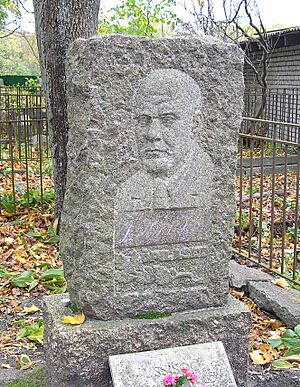Teodor Ussisoo facts for kids
Teodor Ussisoo (also known as Theodor Ussisoo) was a very talented Estonian person. He was born on February 27, 1878, in Paide, Estonia. He passed away on September 26, 1959, in Tallinn. Teodor Ussisoo was many things: a teacher, someone who designed furniture, and an expert in making the inside of buildings look great.
Contents
Early Life and Education
Teodor Ussisoo started his schooling early. From 1888 to 1894, he went to a local district school. After that, he studied at a railway technical college in Tallinn. He attended this college between 1895 and 1898.
Learning Design in Germany
Ussisoo loved to learn new things. He traveled to Germany to continue his studies.
- In 1909, he finished his studies in furniture making in Leipzig.
- Then, in 1913, he graduated from the Köthen Technical Art School. Here, he learned about interior architecture. This means designing the inside spaces of buildings.
Career and Achievements
Teodor Ussisoo had an important career in Estonia. He used his skills to help his country.
A Dedicated Educator
Ussisoo worked as a school teacher in Tallinn for many years. He was very good at teaching. Because of his talent, he became the head of the State Technical School in 1922. This was a very important job.
Designing for Estonia
One of Ussisoo's most famous achievements was his design work for the new Estonian republic. After Estonia became independent in 1918, it needed its own money and stamps.
- Teodor Ussisoo designed the first Estonian kroons. These were the first banknotes for the country.
- He also designed the first postage stamps. These designs helped show Estonia's new independence.
Later Life
Later in his life, Teodor Ussisoo faced some difficult times. In 1949, he was arrested by the authorities during the Soviet period. He was sent far away to a place called Krasnoyarsk Krai. He was released in 1956 and was able to return home.
Family Life
Teodor Ussisoo also had a son named Uno Ussisoo. Uno followed in his father's footsteps in a way. He became an encyclopedist, which means he helped create encyclopedias. He was also a translator, helping people understand different languages.


